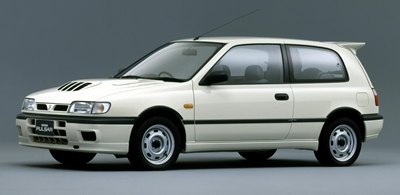 Following the footsteps of
Lancia Delta Integrale, Ford Escort RS Cosworth and Toyota Celica GT-4,
Nissan built a rally special in 1990 to homologate Group A world rally
championship. That was Pulsar GTi-R, or known as Sunny GTi-R in Europe.
Although its racing career was poor and shortlived, the road car was
much better, actually good enough to be rated at the same league as its
rivals.
The Pulsar GTi-R was by no means a good looker due to its modest basis and limited modifications. However, sitting under its pronounced bonnet scoop was the best engine of the class, i.e. Nissan's SR20DET engine. It was shared with the contemporary 200SX, featuring 1998 cc capacity, 16-valve head, Garrett turbocharger and a large intercooler sitting atop it. It produced some 230 hp in domestic trim or 220 hp in European tune, but most impressive was its flexibility. With precious little turbo lag, it worked eagerly from 2000 rpm and spun smoothly beyond 7000 rpm, before hitting the 7500 rpm redline. No other rivalry engines of the time had a better manner. Neither did they feel more potent, especially when the little Nissan was served with a close-ratio 5-speed gearbox. The gearshift was excellent, too, with slick and short-throw action. When the car arrived Europe in 1991, it caused a sensation with its supercar-rivaling performance. The first tests conducted by Autocar, Fast Lane and Performance Car found it took just over 5 seconds to sprint from rest to 60 mph, which was quicker than a Ferrari Testarossa! 0-100 mph of 14.5 seconds beat its rivals by 3 seconds at least. Admittedly, that early test car was probably a particularly good one. Later tests on production cars from 1992 showed 0-60 mph closer to the manufacturer's claim of 6.1 seconds. Still good enough to match the Integrale and Cosworth. However, the Nissan did feel faster on the road due to its better mannered powertrain. Regarding its chassis, less is worth mentioning. Its 4WD system employed a viscous-coupling center differential to distribute power to all wheels. The rear differential also got viscous-coupling. The suspension, like regular Pulsar's, comprised of MacPherson struts up front and struts plus parallel links at the rear. Road tests found the car rode very stiffly and not quite satisfactory as its rivals on bumpy B-roads, although it improved on faster roads. The steering was much better, being quick and communicative. Ditto the powerful brakes. The GTi-R cornered with more body roll than its rivals, but its Achilles' heel should be the 195/55VR14 Bridgestone tires, which were obviously underrubbered thus lacked grip. Its lower cornering limit prevented it from matching its rivals in objective measurements from A to B, even though when it ran out of grip its behavior was benign enough. This shortcoming, in addition to the sleepy look and dull interior, robbed it of the chance of challenging Lancia Delta Integrale as our favorite rally car special. |